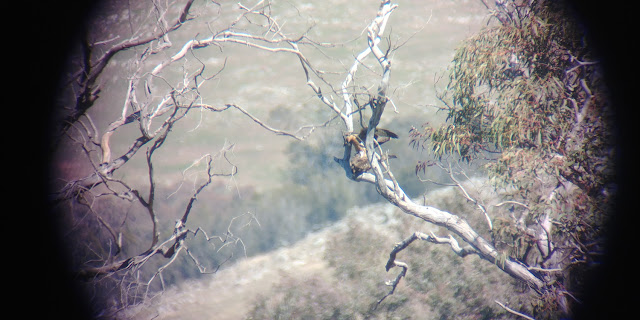From egg to fledge
This female Little Eagle began incubating her egg about 16 September 2020. Her head can be made out on the top right of the nest. This post gives a pictorial description of the incubation and development of their chick. The photographs were taken by Sandra Lauer and her partner Jeremy, from a concealed watch point in a wood 200 m from the nest on an overlooking hillside. The birds never showed any alarm at their occasional distant presence. Little Eagles can nest closer than this to places frequently used by humans. Most people never notice them and the birds carry on with their business.
The male, a pale phase bird, would deliver food to the female either directly to the nest as in this case with a rabbit, or take it to an adjacent tree where she would slip off to eat it. The males usually cover the eggs while the females are off. Most of the incubation is done by the females and most of the hunting by the males who hunt for the females as well as themselves.
After about 36 days, the egg hatched, which would have been about 23 October. But the chicks are difficult to see when small and the females brood them tightly for the first week or so. This shot was taken on 1 November when the chick was just over a week old. It is still pure white and downy, although it can now hold its head up and move about the nest.
A week later, the female spent much of the time shading the chick from the direct sunshine by standing over the nest. This is typical behaviour. Once the chicks are two weeks old they can control their own body temperature more easily and require less brooding by their parents, but excessive direct heat from the sun can overheat chicks.
Once the chick was three weeks old, it was much stronger, shuffling about the nest and watching over its surroundings. The first of the chick's dark feathers are beginning to show, especially its flight feathers which will be the largest. The female still stayed close by, as here, standing on the edge of the nest. The males continue to supply most of the food for all the family.
By the fourth week, the chick is much stronger, standing high on its feet, rather than its heels when younger. The bird is losing more and more of its down by now and it has a pie-bald appearance. Its wings are noticeably dark. The female spent less time at the nest with it, but she would have been watching from nearby.
Six weeks old and the female was still feeding the chick, although by now it could probably tear up small prey itself. Just as when the chick was tiny, the adult presents little pieces of food delicately to the chick. The female is a dark phase bird so the sexes could be easily recognised.
At six weeks, most of the body feathers have grown in and only flecks of down are left on its back and wings. The chick's face shows up white still. The feathers on its back and on the topside of its wings are dark, much darker than those of the parent birds. That is because their feathers are faded by years of exposure to sunlight
Wing stretching is frequently practiced, more and more so as the chick nears fledging age. The chick also spent much time walking along and jumping between branches over the next two weeks. Although the wings look fully feathered they are not quite full length. And the tail is noticeably short. But it is beginning to look like an eagle.
This was the last time the chick was seen in the nest, when about 8 weeks old on 17 December, in a typical squinting view of the nest through a telescope. The adults had been tending egg or chick for three months. And they will still have to care for the chick for perhaps another three months before the family breaks up and they all disperse to their separate winter quarters.
p.s. The fledgling has been seen perched in the nearby wood in January, calling when the adults brought in food.

































